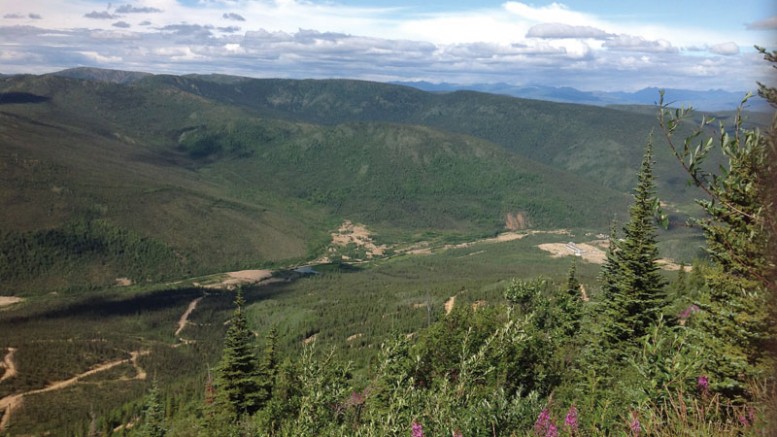While Canada’s Yukon Territory has only one operating mine at the moment — Capstone Mining’s (TSX: CS) Minto copper mine, 240 km north of capital city Whitehorse — it has several projects nearing construction. Here are highlights from three of those projects:
Eagle
Victoria Gold (TSXV: VIT) believes its fully permitted, feasibility-stage heap-leach gold Eagle project could become Yukon’s newest gold mine.
The project, which includes the Eagle and Olive deposits, is on Victoria’s wholly owned Dublin Gulch gold property, 375 km north of Whitehorse and 85 km from the town of Mayo. Combined, the deposits host gold reserves of 2.7 million oz. from 123 million tonnes grading 0.67 gram gold per tonne.
A revised September 2016 feasibility study envisages Eagle as a conventional open-pit, valley-leach operation churning out 190,000 oz. gold a year, over a 10-year mine life, at all-in sustaining costs of US$638 per ounce. The project has an initial US$370-million price tag.

Victoria Gold president and CEO John McConnell at the Dublin Gulch gold project in the Yukon. Photo by Matthew Keevil.
Last November, Victoria raised $4.7 million to continue its drilling efforts at Eagle. It has a $6-million exploration program planned this year to test extensions and drill new targets on the Potato Hills trend.
Along with ongoing exploration, Lenora Hobbis, the company’s executive affairs manager, notes Victoria’s 2017 priorities include pre-construction, project financing and a detailed engineering and construction execution plan.
Once Victoria lines up project financing, construction at Eagle should take one year, after which initial production should start.
Coffee
Goldcorp (TSX: G; NYSE: GG) aims to bring the high-grade Coffee gold project online at the end of 2020.
The major picked up the hydrothermal gold deposit, 130 km south of Dawson City, in a $530-million acquisition of Eira Thomas’ Kaminak Gold last July. Coffee has 2.2 million oz. in reserves (46 million tonnes grading 1.45 grams gold) and potential for new discoveries on its large 600 sq. km land package.
A January 2016 feasibility study shows an open-pit, heap-leach operation at Coffee could support a 10-year life mine, cranking out an average 184,000 oz. gold a year. Expected start-up and all-in sustaining costs are low at $317 million and US$550 per ounce.

Goldcorp’s executive vice-president of corporate affairs and sustainability, Brent Bergeron, at the Coffee gold project’s work camp in the Yukon. Photo by Matthew Keevil.
Since acquiring Coffee, Goldcorp has been optimizing the Kaminak feasibility study and planning upgrades to the site infrastructure, as well as conducting consultations with First Nations and initial studies to support the permitting process.
Goldcorp anticipates permitting and construction activities will take four years, with first gold production expected at the end of 2020.
Keno Hill
Silver-focused Alexco Resource (TSX: AXR; NYSE-MKT: AXU) plans to restart production in Yukon’s Keno Hill silver district.
Alexco entered the historic district in 2006. It briefly operated the past-producing Bellekeno silver mine from 2011 to 2013, before declining metal prices led it to halt the mine and mill. Along with Bellekeno, Alexco owns the past-producing Lucky Queen mine, and the Flame & Moth and Bermingham projects in the district. The four make up the Keno Hill project, which has a total indicated resource of 67.5 million oz. silver (6 million tonnes grading 349 grams silver).

The proposed portal to Alexco Resource’s Flame & Moth deposit at the Keno Hill polymetallic project in the Yukon. Photo by Matthew Keevil.
Alexco listed Bermingham as a “wild card” in its November 2016 presentation, where it outlined plans to resume production from the Bellekeno, Lucky Queen and Flame & Moth deposits. The trio could produce 3 million oz. silver a year for six years, according to a 2015 preliminary economic assessment (PEA). Estimated development costs — which include driving the Flame & Moth decline, inventory build-up and working capital — are $20 million.
Alexco plans to update the PEA with the Bermingham deposit this quarter. This could “impact timelines and costs, depending how it fits into the mix,” the company’s chief financial officer Michael Clark notes.


Be the first to comment on "Yukon Snapshot: Three advanced projects"